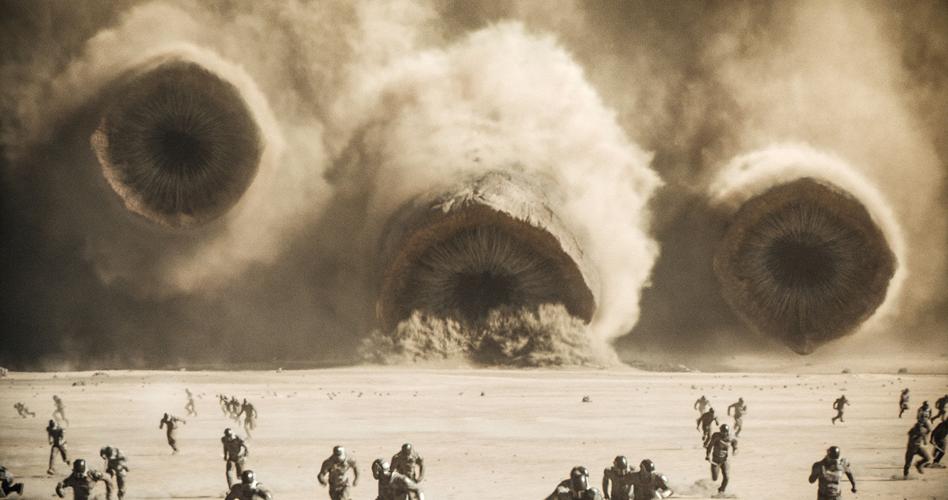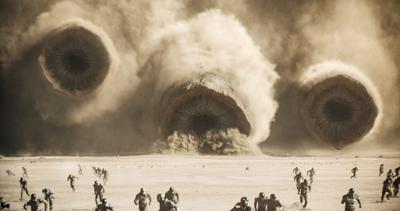When last we left Denis Villenueve’s take on Frank Herbert’s enduring 1965 sci-fi classic Dune, things were in the pre-popping-off stage on the desert world of Arrakis (also called Dune, because Herbert knew history and the way that no besieged place ever bears only one name). The last survivors of the great House Atreides — Lady Jessica (Rebecca Ferguson) and Paul (Timothée Chalamet), driven from their new home by an invading force of the fetish-clad despoilers House Harkonnen — decamp for the desert to learn the ways of the Fremen people.
As for Dune: Part Two, the first two-and-a-quarter hours are close to masterpiece levels of achievement. Especially, presumably, if you can see it on 70 mm film (the press screening was supposed to allow us to do just that), because this film has scope and height and a sense of scale that is truly awesome, in both senses of the word. Befitting what at times can feel like a sci-fi Lawrence of Arabia (though defiantly not in the sly way that co-writer Jon Spaihts’ Prometheus explored that idea), this is a film about expanse, horizon and paths of travel. And when it’s good, it’s very good.
There’s a sequence of the most elegant beauty, in which the Fedaykin Chani (Zendaya) teaches Paul how to walk the sands of the desert without summoning Shai-Hulud (the giant butthole-mouthed sandworms that figure in the key art as well as AMC’s souvenir popcorn bucket campaign). Villeneuve and his cinematographer Greig Fraser photographed it like a dance sequence, the duo’s arrhythmic steps leaving tracks like suras in the sands. It’s breathtaking. There are sequences within the Sietch Tabr that are so dizzy with ideas that you can’t even process it. The film whirls through imagined history as well as the history of imagination, and you want that to keep going on, letting the explosions and the succession take a breather in the background for a bit.
This is a film that luxuriates in the tiny details of a book that lays everything out. You might pick up on how the water-pump systems of the Fremen and the thumpers that they use for calling worms share a common mechanical ancestor. You live in this vibe and it’s exquisite, because in this way it really taps into what the books do so well. I went into this screening — to paraphrase the late, great ODB — ready to bring down the Armageddon if we didn’t get a spice agony and a Guild Navigator. And that’s part of the problem. We get two spice agonies (which are in no way as overwhelming as they really should be) and even a baliset interlude, but no Guild Navigators; it just illustrates that the same fundamental problem that plagued Part One is even more apparent here.
Villeneuve fearlessly tackled a Blade Runner sequel (that’s honestly just as good, if not better, than the original), and time and again he has been adapting this work by sanding off the rough edges and punting the weirdness down the road to the next film. When talking to colleagues after this screening, I discovered that quite a few people still don’t understand what the simultaneous petrochemical/LSD allegory spice melange is and what it does. That is a colossal failure of storytelling, and it’s done out of fear (you know, the mind-killer). Fans of the book (I’ve read all 23 books, and when the board game comes off the shelf, I play as the Tleilaxu) understand how deeply, utterly strange the Dune-iverse can be. This approach to a film series is battling against its own foundations.

Dune: Part Two
Florence Pugh is one of the newcomers to Part Two, playing the chronicler Princess Irulan Corrino — but you wouldn’t know that from anything in this film. We know she’s the daughter of the emperor (Christopher Walken), but their respective characters are so pared down that if you haven’t read the books, you would be lost. And that is the $180 million question. A film of this scale can’t just be made for people who’ve read the books — you also have to give viewers the information to fully experience what they’re undertaking. So how do you adapt a work where you seem to be afraid of so much of it, gathering and depicting moments but slashing away context and detail in direct refutation of what made some of those exquisite moments among the Fremen so moving?
But the filmmakers aren’t afraid of exploring Herbert’s long-term narrative about how messianic movements and religious fundamentalism are dangerous, bloodsoaked endeavors. (This aspect of The Discourse is going to be insane once this film opens. Politically, this movie isn’t pulling any punches at all, and the messy takes are going to be inescapable. But it’s still skittish of its own path into the cosmic and surreal.) If the later Frank Herbert books (we’re talking God-Emperor, Heretics and Chapterhouse) are about anything, it’s freeing oneself from the boundaries of single lives, of canon, of manmade walls, and zooming out to a big picture so big that we don’t have any kind of modern history to compare it to. Herbert’s ambition eclipses so much, and to continually kneecap it to make things accessible to the malnourished appetites of the modern multiplex feels especially shameful. And it’s begrudgingly to Dune: Part Two’s credit that this schism doesn’t become completely insurmountable until the very end.
Villeneuve is a director of great skill and scope, and judging by the last 20 or so minutes of Dune: Part Two, he and Spaihts have no business going any further with this series. (Though Spaihts’ shelved script for a remake of The Black Hole is still No. 1 on my most-want-to-read list.) You do not make great adaptations by making things “easier.” That’s the tragedy of this often very good pair of films. For so much of Part Two, I was convinced I was seeing something truly special. And then to watch as such a film spectacularly shits the bed? Just brutal.
Zendaya gets short shrift by this film — Chani is made into a character of titanic will who is left to stare, hurt and pissed-off, in giant IMAX-sized closeups of lessening effect as they happen again and again. The surprise presence of an unbilled big star in a perfectly expected role to anyone who’s read any of the books is acceptable, even intriguing in the way they are slowly woven into the story in a differing capacity. That is, until yet another choice is made in the last reel that does so much damage — not just to the characters, but to the very structure of the Dune-iverse — that it’s like crashing into a brick wall.
Maybe someone can try and pick up the reins and make something that continues along, but it’s not going to be Children of Dune or Dune: Messiah, at least not in the way the books work. You can’t do a direct literal adaptation of any book, really (aside from Rosemary’s Baby), but the overarching focus that Villeneuve/Spaihts/Eric Roth (from Part One) have chosen is incapable of going where this ride takes you. (Someone definitely needs to give Panos Cosmatos millions of dollars to make God-Emperor of Dune, though, because that is someone who understands both the assignment and how reality-shakingly weird any attempt at these films must be.)
That’s the thing about the Dune-iverse: It covers over 15,000 years of history, and the ending of Dune: Part Two threatens to wall it off in the smallest possible space. For all the talk among the Bene Gesserit characters (who are given significantly less to do this time around, much like the non-Elvis Harkonnens) about plans within plans and playing the long game, this film feels like short-term thinking. And that’s as deadly as any name made a killing word.







